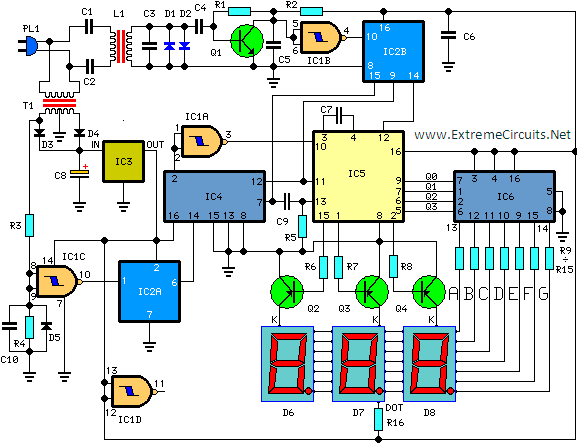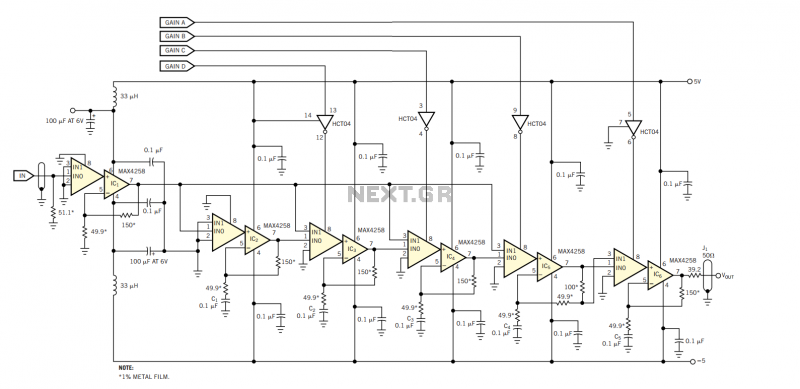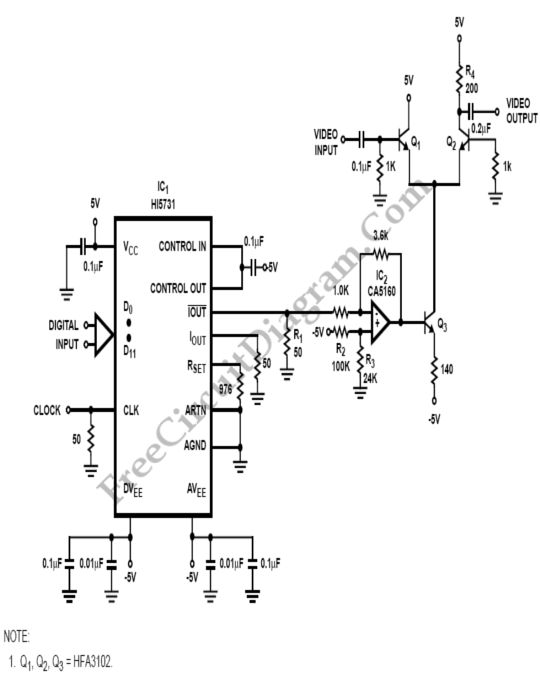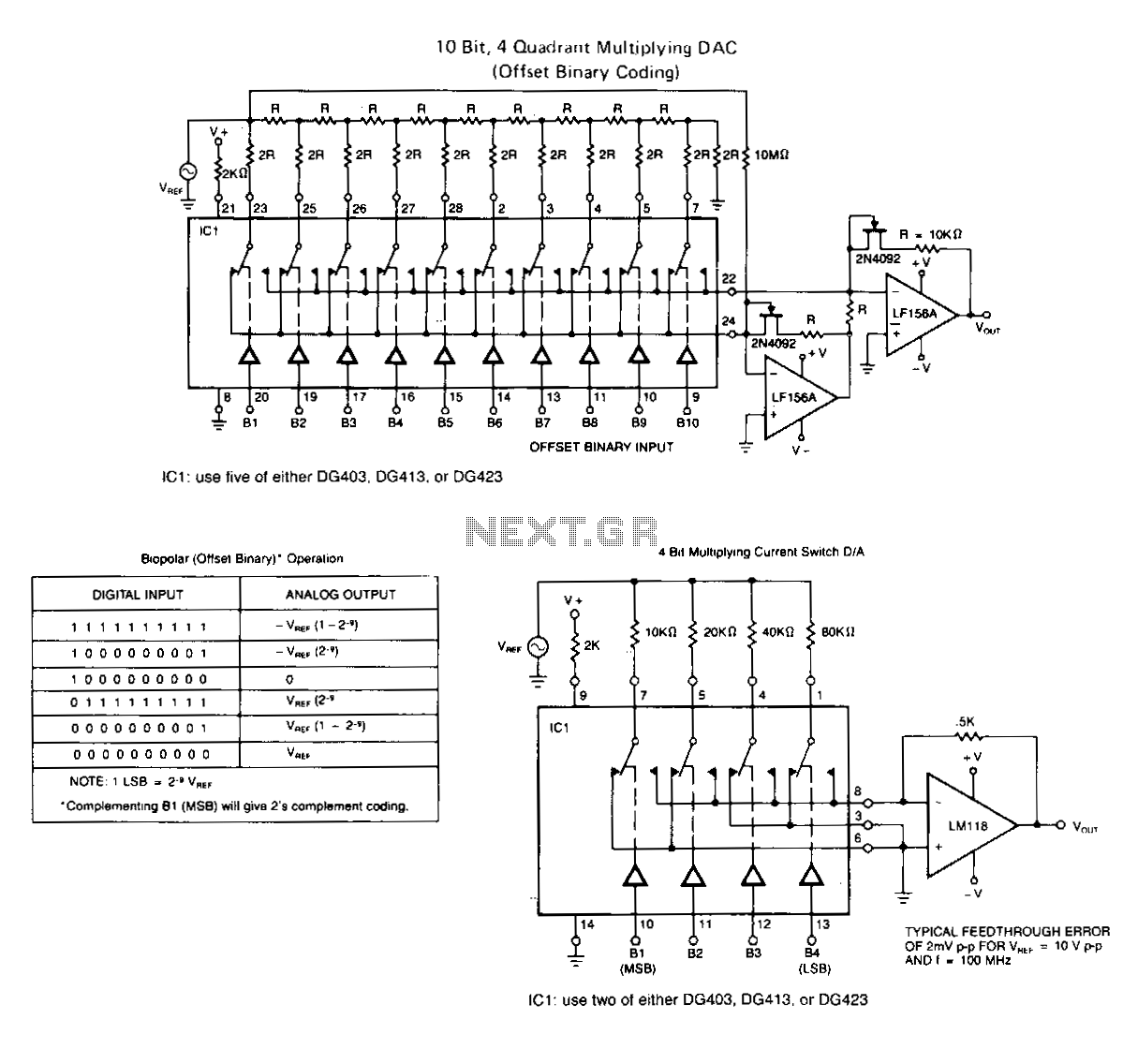
Digital Telemetry with ATMega8
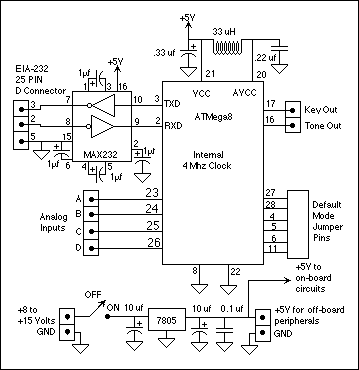
The ATmega8 microcontroller-based Low-Cost Telemetry Device (LTD) is an efficient telemetry keyer. The LTD measures the voltage levels of up to four analog channels via its on-chip 10-bit ADC, converts the measurements to numbers, and then sends the data in Morse code to an external transmitter and to an attached RS-232 terminal. It can be set up either by the RS-232 terminal, in which case, a character string, such as transmitter ID, can be sent, or it can be set up with only jumpers to ground. Parts count is very low, in part because the ATMega8's internal clock is used for timing. The Low Cost Telemetry Device (LTD) provides a low cost, minimal parts count Telemetry keyer using an Atmel's ATMega8 Microcontroller. The LTD sends data by measuring voltage levels of up to four analog channels via its on-chip 10-bit Analog to Digital Converter (ADC) and converting them to numbers and sending the measurements via Morse Code. There are two signal outputs - one is a binary Morse Code signal such as would be used to key a Continuous wave (CW) transmitter, and the other output is tone modulated and could be used to drive a small speaker to the audio input of a transmitter.
Options allow setting code speed to 25, 10, 5 or 1 word per minute, 1 kHz or 500 Hz tone, and measuring 1, 2, 3, or 4 analog channels. The options may be set with jumpers or with an EIA-232 terminal, and in the case of setting it up with a terminal, a text string of up to 80 characters may be sent along with the data. Terminal settings are 9600 Baud, no parity.
The Low-Cost Telemetry Device (LTD) utilizes the ATmega8 microcontroller, which incorporates a 10-bit Analog to Digital Converter (ADC) capable of processing up to four analog input channels. The ADC allows for precise voltage measurements, converting these readings into digital data suitable for transmission. The data is subsequently encoded into Morse code, facilitating communication with an external Continuous Wave (CW) transmitter or an audio input for a speaker, enhancing versatility in its applications.
The device is designed for ease of configuration. Users can set operational parameters via an RS-232 terminal or by utilizing jumper settings. This dual configuration method enables flexibility in deployment, allowing users to input a unique identifier or other relevant data strings of up to 80 characters, which can be transmitted alongside telemetry data. The system operates at a baud rate of 9600 with no parity, ensuring reliable data transmission.
The LTD's operational parameters can be adjusted to suit various use cases. Users can select Morse code transmission speeds ranging from 1 to 25 words per minute, as well as tone modulation options at 1 kHz or 500 Hz. This adaptability makes the device suitable for a wide range of applications, including amateur radio operations, telemetry for unmanned aerial vehicles, and monitoring environmental parameters such as liquid levels in tanks or streams.
The simplicity and reliability of Morse code, even in modern communication contexts, are significant advantages of the LTD. Its design emphasizes minimal parts count, leveraging the internal clock of the ATmega8 for timing functions, which contributes to a cost-effective solution for telemetry applications. The continued relevance of Morse code in specific fields, such as amateur radio, underscores the device's utility in both hobbyist and professional settings.The ATmega8 microcontroller-based Low-Cost Telemetry Device (LTD) is an efficient telemetry keyer. The LTD measures the voltage levels of up to four analog channels via its on-chip 10-bit ADC, converts the measurements to numbers, and then sends the data in Morse code to an external transmitter and to an attached RS-232 terminal. It can be set up either by the RS-232 terminal, in which case, a character string, such as transmitter ID, can can be sent, or it can be set up with only jumpers to ground.
Parts count is very low, in part because the ATMega8's internal clock is used for timing. The Low Cost Telemetry Device (LTD) provides a low cost, minimal parts count Telemetry keyer using an Atmel's ATMega8 Microcontroller. The LTD sends data by measuring voltage levels of up to four analog channels via its on-chip 10-bit Analog to Digital Converter (ADC) and converting them to numbers and sending the measurements via Morse Code.
There are two signal outputs - one is a binary Morse Code signal such as would be used to key a Continuous wave (CW) transmitter, and the other output is tone modulated and could be used to drive a small speaker to the audio input of a transmitter. Options allow setting code speed to 25, 10, 5 or 1 word per minute, 1 kHz or 500 Hz tone, and measuring 1, 2, 3, or 4 analog channels.
The options maybe set with jumpers or with and EIA-232 terminal, and in the case of setting it up with a terminal, a text string of up to 80 characters maybe sent along with the data. Terminal settings are 9600 Baud, no parity. Thoroughly Modern Morse Morse code , now over 150 years old, has long since faded from use by Coast Guard, Navy and other Military Services in favor of modern communications modes usually carried over microwave or Satellite links.
So one must ask , why use Morse code when we have things like Bluetooth or 802.11 to send data? The answer is simplicity and reliability. When Samuel Morse demonstrated the Telegraph to Congress in 1844 it was clear that one of the key features of his device was simplicity. Only later would the use of RF demonstrate it's robustness in poor RF conditions. Besides it's reliability, good signal to noise ratio and simplicity factor, Morse code has one more feature that makes it thoroughly modern: the ability to be decoded by human ear.
Morse Code still has millions of Amateur Radio fans around the world who swear by it's ability to "get through" when RF conditions are poor. Although no longer used as the defacto communications mode it is still required knowledge by military Special Forces and some Amateur Radio Operators licenses.
In the special case of Amateur Radio use, the data identification string can be programmed into the controller to provide proper ID or other supplemental information when using the device as a repeater controller or automatic keyer. For example, Amateur Radio Operators can use the LTD as a Contest Keyer by turning the analog to digital channels off and entering a text "CQ" message.
The range of uses also includes amateur rocketry and unmanned balloons, repeater station operating parameters, manufacturing process parameters, or liquid levels such as those in fuel tanks or water courses. 🔗 External reference
Options allow setting code speed to 25, 10, 5 or 1 word per minute, 1 kHz or 500 Hz tone, and measuring 1, 2, 3, or 4 analog channels. The options may be set with jumpers or with an EIA-232 terminal, and in the case of setting it up with a terminal, a text string of up to 80 characters may be sent along with the data. Terminal settings are 9600 Baud, no parity.
The Low-Cost Telemetry Device (LTD) utilizes the ATmega8 microcontroller, which incorporates a 10-bit Analog to Digital Converter (ADC) capable of processing up to four analog input channels. The ADC allows for precise voltage measurements, converting these readings into digital data suitable for transmission. The data is subsequently encoded into Morse code, facilitating communication with an external Continuous Wave (CW) transmitter or an audio input for a speaker, enhancing versatility in its applications.
The device is designed for ease of configuration. Users can set operational parameters via an RS-232 terminal or by utilizing jumper settings. This dual configuration method enables flexibility in deployment, allowing users to input a unique identifier or other relevant data strings of up to 80 characters, which can be transmitted alongside telemetry data. The system operates at a baud rate of 9600 with no parity, ensuring reliable data transmission.
The LTD's operational parameters can be adjusted to suit various use cases. Users can select Morse code transmission speeds ranging from 1 to 25 words per minute, as well as tone modulation options at 1 kHz or 500 Hz. This adaptability makes the device suitable for a wide range of applications, including amateur radio operations, telemetry for unmanned aerial vehicles, and monitoring environmental parameters such as liquid levels in tanks or streams.
The simplicity and reliability of Morse code, even in modern communication contexts, are significant advantages of the LTD. Its design emphasizes minimal parts count, leveraging the internal clock of the ATmega8 for timing functions, which contributes to a cost-effective solution for telemetry applications. The continued relevance of Morse code in specific fields, such as amateur radio, underscores the device's utility in both hobbyist and professional settings.The ATmega8 microcontroller-based Low-Cost Telemetry Device (LTD) is an efficient telemetry keyer. The LTD measures the voltage levels of up to four analog channels via its on-chip 10-bit ADC, converts the measurements to numbers, and then sends the data in Morse code to an external transmitter and to an attached RS-232 terminal. It can be set up either by the RS-232 terminal, in which case, a character string, such as transmitter ID, can can be sent, or it can be set up with only jumpers to ground.
Parts count is very low, in part because the ATMega8's internal clock is used for timing. The Low Cost Telemetry Device (LTD) provides a low cost, minimal parts count Telemetry keyer using an Atmel's ATMega8 Microcontroller. The LTD sends data by measuring voltage levels of up to four analog channels via its on-chip 10-bit Analog to Digital Converter (ADC) and converting them to numbers and sending the measurements via Morse Code.
There are two signal outputs - one is a binary Morse Code signal such as would be used to key a Continuous wave (CW) transmitter, and the other output is tone modulated and could be used to drive a small speaker to the audio input of a transmitter. Options allow setting code speed to 25, 10, 5 or 1 word per minute, 1 kHz or 500 Hz tone, and measuring 1, 2, 3, or 4 analog channels.
The options maybe set with jumpers or with and EIA-232 terminal, and in the case of setting it up with a terminal, a text string of up to 80 characters maybe sent along with the data. Terminal settings are 9600 Baud, no parity. Thoroughly Modern Morse Morse code , now over 150 years old, has long since faded from use by Coast Guard, Navy and other Military Services in favor of modern communications modes usually carried over microwave or Satellite links.
So one must ask , why use Morse code when we have things like Bluetooth or 802.11 to send data? The answer is simplicity and reliability. When Samuel Morse demonstrated the Telegraph to Congress in 1844 it was clear that one of the key features of his device was simplicity. Only later would the use of RF demonstrate it's robustness in poor RF conditions. Besides it's reliability, good signal to noise ratio and simplicity factor, Morse code has one more feature that makes it thoroughly modern: the ability to be decoded by human ear.
Morse Code still has millions of Amateur Radio fans around the world who swear by it's ability to "get through" when RF conditions are poor. Although no longer used as the defacto communications mode it is still required knowledge by military Special Forces and some Amateur Radio Operators licenses.
In the special case of Amateur Radio use, the data identification string can be programmed into the controller to provide proper ID or other supplemental information when using the device as a repeater controller or automatic keyer. For example, Amateur Radio Operators can use the LTD as a Contest Keyer by turning the analog to digital channels off and entering a text "CQ" message.
The range of uses also includes amateur rocketry and unmanned balloons, repeater station operating parameters, manufacturing process parameters, or liquid levels such as those in fuel tanks or water courses. 🔗 External reference
Warning: include(partials/cookie-banner.php): Failed to open stream: Permission denied in /var/www/html/nextgr/view-circuit.php on line 713
Warning: include(): Failed opening 'partials/cookie-banner.php' for inclusion (include_path='.:/usr/share/php') in /var/www/html/nextgr/view-circuit.php on line 713
